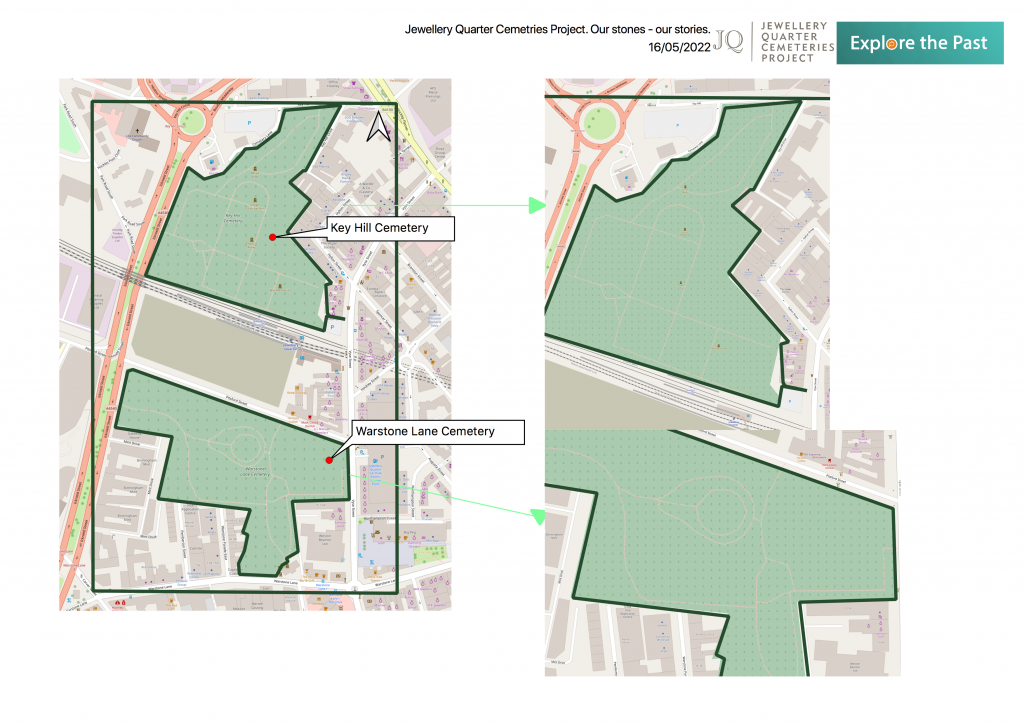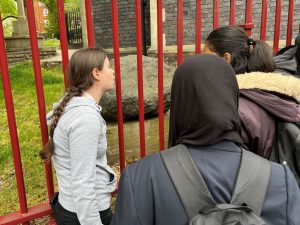Our stones, our stories
- 9th June 2022
Working with the Jewellery Quarter Cemetries Project (part of the Jewellery Quarter Business Improvement District ) we are running an after-school Heritage Club based at the Jewellery Quarter Academy that includes youngsters from other local schools.
Running since early May 2022, we meet weekly to do a classroom session then a hands on session – generally go out to the local cemeteries – looking at the history of the cemeteries, the stones, the memorials, the people being commemorated (including their cultural in context) and the archaeology of the cemetery and stones.
By culture in context we mean that the people were from different cultures that they brought with them in the context of their new lives and the people around them.
The cemeteries
Developing Birmingham invited progressive people. This development brought people from around the world to Birmingham, many of which ended up in cemeteries like the Key Hill and Warstone Lane cemeteries.
Note: Warstone Lane cemetery got it’s name from the large stone that was deposited at the top of the road just inside the are of the cemetery today. The stone (first recorded in 1390) is associated with the boundary of the district and such stones were used as levying points in times of war – hence the name Warstone.
What we do?
A typical afterschool club session is in two parts – a classroom session and an activity. The classroom sessions have included information about the local area of the Jewellery Quarter such as how the architecture of the buildings reflect the building use and the practical side of the work being done by the people that worked there and the people that lived and worked in the area and onto entering data gathered from the previous week into a database and a website created for the project.
We have had some great discussions with the youngsters about heritage, culture, commemoration, colonialism, context and community. One of the group’s practical sessions has been about recording oral histories from family members about what it was like to move to Birmingham and their earliest memories.
Following the classroom session we do activities such as writing with dipping pens, how to record oral histories of family members, a tour of the Key Hill and Warstone Lane cemeteries, a tour of the Jewellery Quarter and how the buildings have changed use from factories and workshops (some of which still exist) to housing.
One of the cemetery tours looked at the memorials, the names and dates, and with the incredible stories from Rahma & Zak who talked to us about their research into some of the people (see the ‘Colonialism Connections’ tour).
What next?
After the June half-term break, we have engaged the youngsters in doing field archaeology …excavating, recording, photographing, reporting and presentation of the work.
We will be chosing a location to dig and explore if there is a buried stone, we will be recording those around it (what shape of the stone and the grave, what the inscription says and who was buried there), and basing a search on a geophysical map of the cemetery (a geophysical survey was carried out by the Jewellery Quarter Cemeteries Project so grave and stone locations could be identified) we will find the another stone to uncover.
What are the youngsters getting out of it?
The club attendees are telling their family stories about moving to or living in Birmingham and how they are getting a respect for each other and other people, particularly the people in the cemeteries who were people of Birmingham and though their stories or circumstances were sometimes tragic, sometimes awe-inspiring, they have a place in Birmingham’s history and heritage.
Have you got a project?
If you have a project you would like help with, we have the specialist staff and the resources to help you and the youngsters learn by getting involved.
Have a look at our working with us page for more information.


Post a Comment